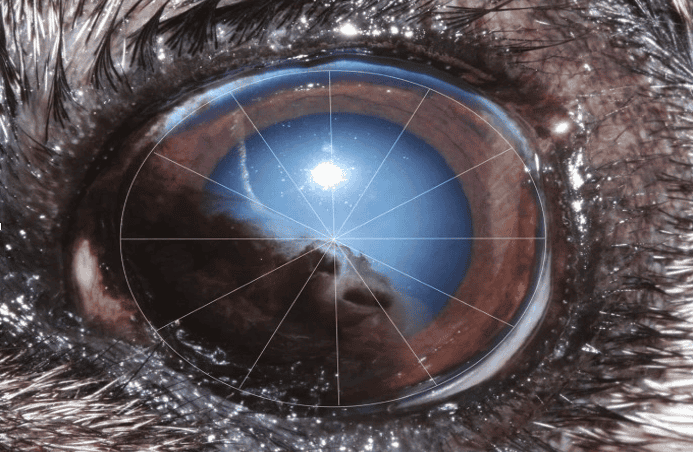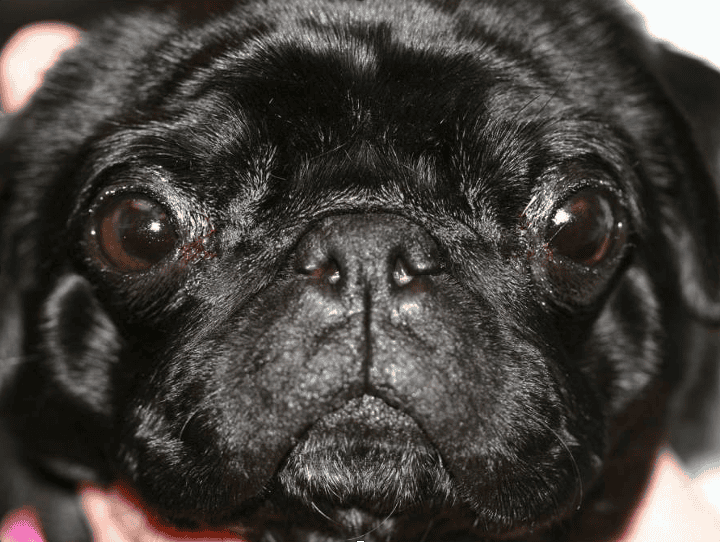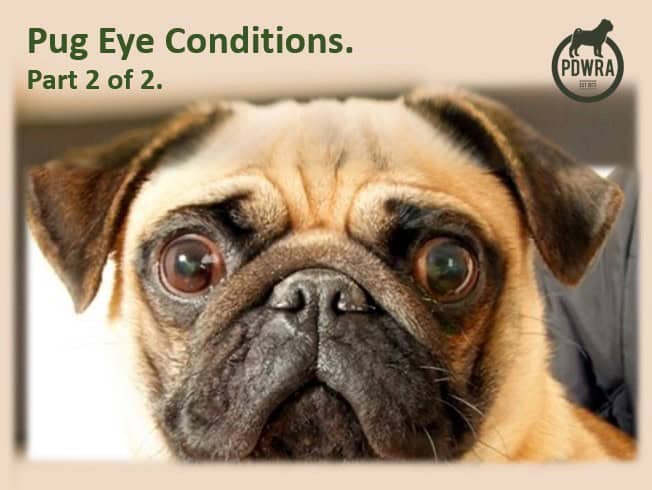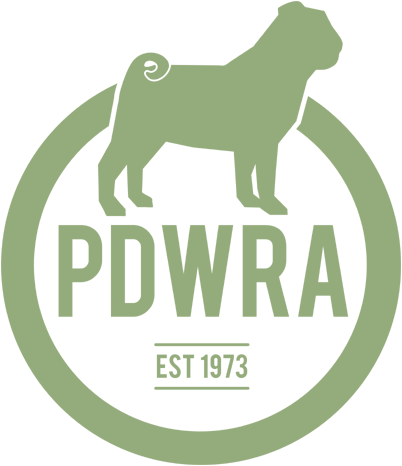This is a follow on from my last article (Pug Eye Conditions: Part 1 of 2) where I discussed corneal ulceration in pugs; causes and treatment.
The conditions I am discussing today are all inter-related; causes of which are similar to those that can result in a corneal ulcer.
Because the bony orbit where the eye rests is very shallow in a pug (due to breeding the brachycephalic head shape), the eyes protrude more than a dog with a snout, which results in too much of the white of the eye showing as per below photograph.
This can result in the following conditions discussed below:-
- Proptosis
- Dry Corneas
- Pigmentary Keratitis
The other two conditions discussed, entropion and distichiasis, are also seen commonly in pugs.
All five conditions can be treated to varying degrees with an operation called a (bilateral) medial canthoplasty or blepharoplasty, which I will describe at the end of the article.
Proptosis
This is where the eye globe becomes displaced out of the bony orbit where it normally sits.
It can often occur after trauma, which can be as little as a slight bang to the head due to the orbit being so shallow.
This is an ocular emergency as the optic nerve is stretched (and can be potentially torn), muscles are damaged and the cornea is completely exposed. If not operated on promptly, the eye will be non-viable.
If the eye cannot be saved /has no vision, the best treatment is removal (enucleation) of the eye.
Keratoconjunctivitis Sicca (KCS) or Dry Eye
Pugs are prone to Dry Eye, which is where not enough tears are produced by the eye.
They can also have a dry eye, due to the poor quality of tears. And, because of the conformation of a pug’s eye where is bulges excessively, the cornea can become dry because the eyelids don’t actually close together even when the dog is asleep.
A dry cornea can lead to pigment being deposited (PK) on the cornea (see below), as well as the eye being prone to ulceration (discussed previously)
Treatment for KCS involves stimulating tear production with medication. I’m sure many of you are familiar with Optimmune as an eye ointment to treat dry eye, along with Tacrolimus. The latter is also used to reduce the progression of pigmentary keratitis.
As mentioned previously, because of pug’s bulging eyes and proneness to a dry cornea, I use an eye lubricant on my pugs twice daily to help moisturise the cornea and hopefully reducing the likelihood of conditions that develop as a result of a dry cornea (PK, corneal ulceration). I use Carbomer (cheap off Amazon) on my younger pugs, and Lacrilube (now called Xailin Night) on my older pugs, but there are other products available.
Pigmentary Keratitis (PK)
This condition is where pigment is deposited on the surface of a cornea, and can be seen as a black/brown film.
The cause is multi-factorial including excessive exposure of the cornea allowing it to become dry, irritation through eyelashes rubbing on the cornea and a genetic predisposition.
Again, I am sure many of you have seen this pigment on your pug’s eye. The condition is often progressive, and can result in blindness when it covers all the pupil.
Treatment can often involve use of medication for KCS, as well as surgery to reduce the amount of eye exposed ( see base of article).
Laser surgery can also be considered, which will require a specialist ophthalmologist, however it is very expensive and needs a large amount of post-operative care.

Entropion
This condition is commonly seen in pugs, where the eyelids turn inwards, especially at the nose side (medially) which results hairs/eyelashes rubbing on the cornea causing irritation.
Distichiasis
This is where eyelashes (cilia) grow in an abnormal position on the eyelid and rub on the cornea. These hairs can be removed by plucking out (epilating) or by various cauterising treatments though unfortunately the hairs can often grow back.
Medial Canthoplasty or Blepharoplasty
This surgery, known as a medial (often both eyes are operated on and therefore a bilateral medial) canthoplasty of blepharoplasty, is used to treat entropion, and dry corneas, as well as too protruding eyes and prevention of proptosis and pigment deposition (PK).
It essentially shortens the eyelids making the eye openings smaller by closing the inner aspect (at nose side) of the eyelids together as illustrated below.
The effect of this is to improve the dog’s ability to blink and it reduces the overall exposure of the dog’s eye.

The photo shows a pug with recent medial canthoplasty surgery.
In summary
Unfortunately pugs are prone to a number of significant eye conditions, mainly related to their breeding and being brachycephalic. Treatment can involve either eye medication and/or surgery, which can lead to improvement, however treatment is expensive especially the eye operations, which need to be carried out by a specialist.
This is a quick run through of some conditions, however the list is not exhaustive, and is an overview only. More information can be found on the internet, especially with referral veterinary ophthalmologist websites.
And, remember that prevention or early intervention has the best outcomes.
Helen McKee (MRCVS)
Veterinary Advisor for the PDWRA
*******
Other PDWRA Pug Health Articles.
For more information on Pug Eye Conditions, please see: Eye Problems | The Pug Dog Welfare & Rescue Association
&
Other Pug Health Conditions, please see: Pug Health & Wellbeing | The Pug Dog Welfare & Rescue Association



